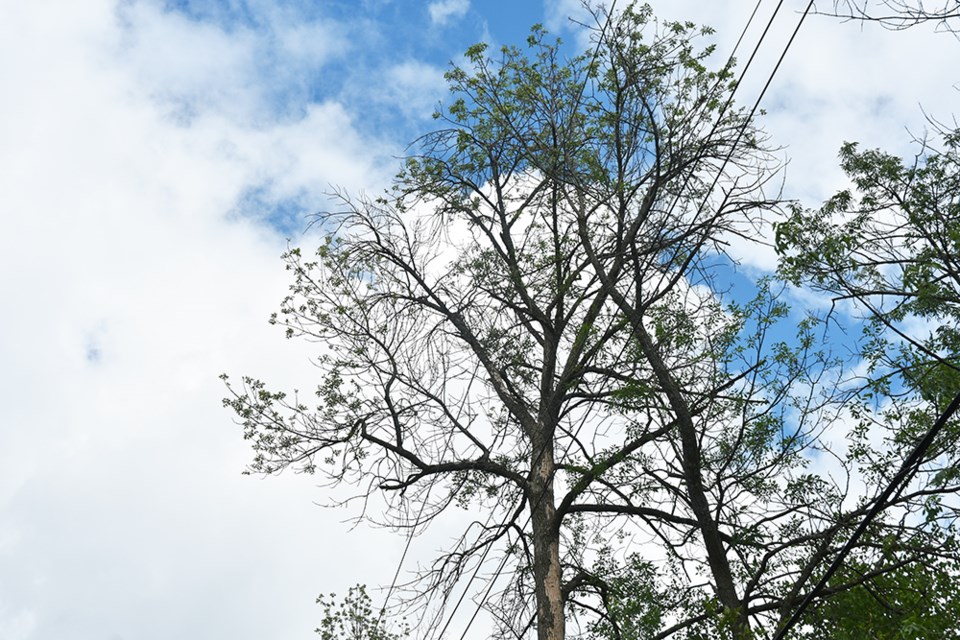There are more and more dead and dying trees to be seen along roadsides, in yards and in parks across South Simcoe.
The majority are ash trees, killed off by an infestation of the invasive Emerald Ash Borer, Agrilus planipennis.
Native to Asia, Emerald Ash Borer (EAB) is believed to have been accidentally introduced into North America in untreated wooden packing materials in the early 1990s.
First detected in dead and dying trees near the Canada-U.S. border between Michigan and Ontario in 2002, the insect pests have spread relentlessly – killing millions if not billions of ash trees, from Manitoba to New Brunswick.
As Natural Resources Canada notes, without any natural predators to halt the spread, “up to 99 percent of all ash trees are killed within eight to 10 years, once the beetle arrives in an area.”
Bradford West Gwillimbury was the first municipality in Simcoe County to recognize the infestation, back in 2013 – shortly after EAB had been found in neighbouring York Region.
An inventory of Ash trees on municipal property identified 229 ash trees vulnerable to the pest. The town decided to attempt to preserve larger trees only, removing low-value trees or those with significant die-back, and replacing them with other species.
“High value, large caliper (diameter) trees have been our focus – approximately 150, mostly on boulevards,” said Mike O’Hare, Manager of Parks and Properties.
Contractors were hire to treat significant trees with TreeAzin, an injectable insecticide derived from the Neem Tree, on a two-year cycle. The $50,000 per year cost has been part of the urban forestry budget.
BWG is “continuing to treat and seeing good results,” said O’Hare, but there is a caveat: “The town only addresses publicly-owned trees. No private trees are part of the treatment program.”
Private homeowners can contact a certified company or arborist, to look into treatment for their own trees, but are on their own, as far as cost or removal.
The municipality has a regular maintenance program to remove dead trees on town-owned property.
“If sections of a dead ash tree are overhanging public land and could cause a safety issue, the town may remove the dead wood,” O’Hare noted.
The Town of Innisfil has been slower to react to the spread of EAB, but in 2018 the municipality completed an inventory of all the ash trees located on town-owned property.
“Over 1,000 ash trees were identified in the study, and an Emerald Ash Borer Management Plan was prepared, including a proactive management strategy over a multi-year program for the removal and replacement, as required, of these trees,” Innisfil staff noted.
The program has an annual budget of $125,000 per year. No treatment option was included in the plan.
Innisfil has now retained a contractor, who began the program of removal of the dead and dying trees last year. Town staff are also participating in the work.
Again, the program covers only municipally-owned land. “The program is for ash trees on town-owned properties only. Landowners are responsible for the trees on their own property,” the town noted.
As part of its management plan, Innisfil is replanting, where appropriate, with species that include sweet gum, blue beech, catalpa, hackberry, honey locust, black locust, and a wide variety of maple and oak species.
The list includes a number of ‘Carolinian Species’, once native to an area of Ontario further south; the impact of climate change has meant that many can now survive further north.
It can take EAB only three years from the first signs of infestation, to kill what was a healthy tree. The borer larvae girdle the tree, tunnelling through the soft cambium underneath the bark, and cutting off the flow of water and nutrients.
And Natural Resources Canada is no longer recommending treatment, as a way to save the ash. Now, the strategy is to collect and save ash tree seeds for a possible future scenario, when the borer has finished its destructive work and died off.



